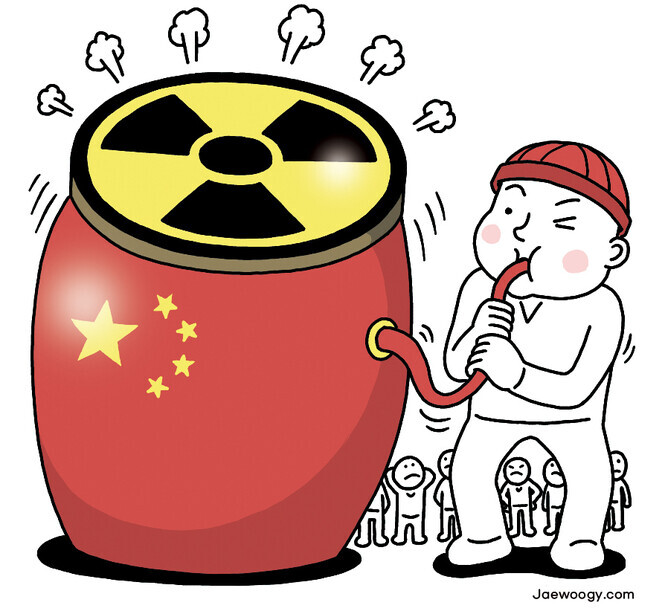hankyoreh
Links to other country sites 다른 나라 사이트 링크
[Column] China’s uneasy great leap forward in nuclear energy

The Chinese government announced plans for the construction of multiple new power plants, which also marked the 10th anniversary of the Fukushima Nuclear Power Plant disaster in Japan.
Presented during a session of the National People’s Congress that ended on March 11, China’s 14th Five-Year Plan included plans for increasing the capacity of the country’s nuclear power facilities to 70 gigawatts (GW) by 2025.
This would be a rapid increase in capacity from the 51GW currently provided by China’s nuclear power plants. According to the plan, China is to actively pursue the construction of state-of-the-art third-generation reactors along its coast and build “floating marine nuclear power platforms” with nuclear reactors placed on ships.
China has 49 nuclear reactors currently online, ranking it third worldwide behind the US (94) and France (56). But while the US and France have been reducing their construction of nuclear power plants, China either is building or plans to build 55 new reactors — meaning that it will have the world’s largest number of power plants within just a few years.
In 1964, China became the fifth country in the world to develop a nuclear bomb. But its history with nuclear power is relatively short.
In December 1991, it brought its first nuclear power plant online — the Qinshan Nuclear Power Plant in Jiaxing, Zhejiang Province — using technology introduced from Canada.
It later suspended all of its nuclear power plant project reviews in the wake of the Fukushima disaster, but in 2015 it put its power plant plan back in motion. It has been working to speed up its nuclear power expansion efforts to meet growing energy demand while reducing atmospheric pollution from coal-fired power.
In September 2020, it began operation of the Fuqing 5 reactor, the first to apply China’s independently developed state-of-the-art third-generation Hualong One reactor technology.
China’s nuclear plants are located chiefly along its southeastern coast in the provinces of Guangdong, Fujian, Zhejiang and Shandong. This means that if an accident were to occur, there would be a serious risk of radioactive contaminants being carried into South Korea’s West Sea and southern waters on ocean currents and westerlies.
According to reports, one of the floating nuclear power plants — which environmental groups have worriedly described as “floating Chernobyls” — is scheduled to go online in the near future near Yantai, Shandong Province, just 400km from Incheon.
In the wake of the Fukushima disaster, China had its own civil society campaign against the expansion of nuclear power. The construction of a nuclear fuel factory in Jiangmen, Guangdong Province, was halted in 2013 due to demonstrations by the public. In 2016, the building of a nuclear waste disposal facility in Lianyungang, Jiangsu Province, was canceled.
But the criticisms have vanished since then amid intensifying efforts by Chinese authorities to suppress civil movements.
Instead, the only voices ringing out now are boasts about China’s “autonomous development” of nuclear reactors and calls to resume inland nuclear power plant construction efforts that were suspended after the Fukushima disaster. It’s the unsettling shadow that lurks behind China’s sloganeering about a “community of common destiny for humankind.”
By Park Min-hee, editorial writer
Please direct comments or questions to [english@hani.co.kr]

Editorial・opinion
![[Editorial] Yoon must halt procurement of SM-3 interceptor missiles [Editorial] Yoon must halt procurement of SM-3 interceptor missiles](https://flexible.img.hani.co.kr/flexible/normal/500/300/imgdb/child/2024/0501/17145495551605_1717145495195344.jpg) [Editorial] Yoon must halt procurement of SM-3 interceptor missiles
[Editorial] Yoon must halt procurement of SM-3 interceptor missiles![[Guest essay] Maybe Korea’s rapid population decline is an opportunity, not a crisis [Guest essay] Maybe Korea’s rapid population decline is an opportunity, not a crisis](https://flexible.img.hani.co.kr/flexible/normal/500/300/imgdb/original/2024/0430/9417144634983596.jpg) [Guest essay] Maybe Korea’s rapid population decline is an opportunity, not a crisis
[Guest essay] Maybe Korea’s rapid population decline is an opportunity, not a crisis- [Column] Can Yoon steer diplomacy with Russia, China back on track?
- [Column] Season 2 of special prosecutor probe may be coming to Korea soon
- [Column] Park Geun-hye déjà vu in Yoon Suk-yeol
- [Editorial] New weight of N. Korea’s nuclear threats makes dialogue all the more urgent
- [Guest essay] The real reason Korea’s new right wants to dub Rhee a founding father
- [Column] ‘Choson’: Is it time we start referring to N. Korea in its own terms?
- [Editorial] Japan’s rewriting of history with Korea has gone too far
- [Column] The president’s questionable capacity for dialogue
Most viewed articles
- 1Months and months of overdue wages are pushing migrant workers in Korea into debt
- 2Trump asks why US would defend Korea, hints at hiking Seoul’s defense cost burden
- 3At heart of West’s handwringing over Chinese ‘overcapacity,’ a battle to lead key future industries
- 4[Editorial] Yoon must halt procurement of SM-3 interceptor missiles
- 5Fruitless Yoon-Lee summit inflames partisan tensions in Korea
- 6AI is catching up with humans at a ‘shocking’ rate
- 7Dermatology, plastic surgery drove record medical tourism to Korea in 2023
- 81 in 3 S. Korean security experts support nuclear armament, CSIS finds
- 946% of cases of violence against women in Korea perpetrated by intimate partner, study finds
- 10Amnesty notes ‘erosion’ of freedom of expression in Korea in annual human rights report